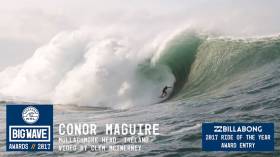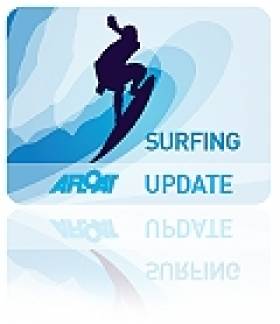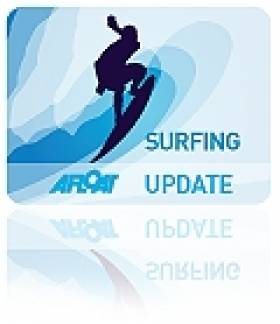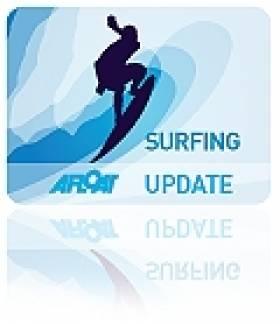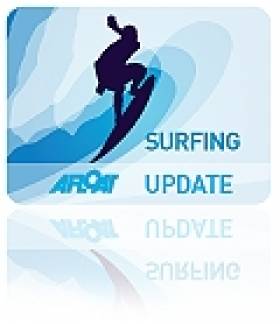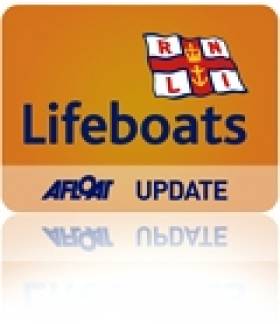Displaying items by tag: mullaghmore
They’ve been holding annual regattas at breezy Mullaghmore on Sligo’s northwest coast for a very long time. Probably way beyond 1885, but that’s the oldest regatta poster they’ve managed to unearth. And though it’s just about possible to decipher it, we’ll run it in the “clear modern” style as well to give the flavour of sports and sailing and shore life and country life all being celebrated in a mixed together sort of way all of 145 years ago.
Which, come to think of it, is what domestic life has been like these past few months with Lockdowns and whatnot. But with a tradition like the Mullaghmore Regatta spirit to bring everyone to life, as soon as closures eased even a little bit it was immediately time to dust off the old posters, create a new one for 24th-26th July 2020 (and very stylish it is too), and give us a moment to consider what it was like in 1885.
 Relic of oul decency – we can still identify with much of the information in the 1885 Mullaghmore Regatta poster.
Relic of oul decency – we can still identify with much of the information in the 1885 Mullaghmore Regatta poster.
MULLAGHMORE REGATTA
Tuesday, August 24th (Ed’s note: it was 1885)
COMMITTEE:
Colonel Wood-Martin J.W.Tate MD
William Alexander C.R. Kincaid
Bernard Harte
JAMES M’GLOIN, Hon.Sec. and Treasurer
SAILING RACES
First Race- For boats under ten tons; a flying start at eleven o’clock
Second Race- Trawlers under four tons; start same time
Third Race: Green Castle Yawls; start same time.
ROWING RACE
Open to Four-oared Green Castle Yawls
The sports will terminate with a Donkey Race.
Entrance Money to be lodged with the Hon. Sec, not later than ten o’clock on the morning of the Races, when the amount of the prizes will be declared. Starting Points and Courses to be arranged by the Committee on the morning of the Races. Decisions of the Committee to be final in any disputed case. Any objector to lodge Five Shillings with his written objection. The money to be applied to the Regatta Fund should the objection prove frivolous.
N. B. Tents will not be allowed on the Green
The first thing we notice is that it was held on a Tuesday. As we’re emerging from a weird period in which one day merged into another until you couldn’t really say what day it is or was, that doesn’t seem quite such a big deal now. But in the times BC (Before Coronavirus) when all was precision and rush and go and stick strictly to timetables, the complete lack of total worship of the Sacred Weekend would have seemed unnerving.
As for the other information in that 1885 poster, much of it speaks for itself, but for the uninitiated, the Green Castle Yawls are the ubiquitous clinker-built double-enders maybe about 25ft long which were based on the imported Drontheim (Trondheim) boats, which were brought from Norway in considerable numbers mostly to Derry as deck cargo, and then copied and beefed up by Irish builders mainly along the north coast, and most notably at Greencastle in Donegal at the entrance to Lough Foyle.
 Classic re-creation of a Greencastle yawl – this is the Portrush-based community-built James Kelly, named in honour of the local boatbuilder who crafted quality fishing boats and yachts, including two Dublin Bay 21s in 1903. Photo: W M Nixon
Classic re-creation of a Greencastle yawl – this is the Portrush-based community-built James Kelly, named in honour of the local boatbuilder who crafted quality fishing boats and yachts, including two Dublin Bay 21s in 1903. Photo: W M Nixon
In time the tradition spread to local builders on down the west coast, a noted focal point for this being the mysterious Milk Harbour south of Mullaghmore, a secret inlet hidden among the sand-dunes which march along this coast beside the beaches which proved the undoing of the ships of the Spanish Armada.
 Racing at Mullaghmore in the sheltered bay - big country, big sailing, big-hearted people. Photo: MSC
Racing at Mullaghmore in the sheltered bay - big country, big sailing, big-hearted people. Photo: MSC
Yet while those Atlantic-facing beaches are notoriously exposed, just a few miles along the coast to the northeast the rugged little headland of Mullaghmore curves round to provide total shelter in the extensive bay to the eastward, ideal regatta racing water with the spice of the open sea close by to give the offshore racers a run for their money. Whether or not all that money still goes into the prize pot, we can only guess. Either way, it’s all happening this weekend at Mullaghmore.
 Distinguished visitor. Noted antiquarian bookseller Ed Maggs brings his “modern classic” gaff ketch Betty Alan to Mullaghmore Regatta 2019. Photo Brian Mathews
Distinguished visitor. Noted antiquarian bookseller Ed Maggs brings his “modern classic” gaff ketch Betty Alan to Mullaghmore Regatta 2019. Photo Brian Mathews
Two Irish Surfers Up For 2017 Big Wave Prize
#Surfing - Two Irish surfers are nominated for ride of the year in the 2017 WSL Big Wave Awards after taking on the monster swell at Mullaghmore Head last month.
Conor Maguire and Peter Conroy were in the right place at the right time on 9 February to get a tow-in to the ‘emerald walls’ at the surfing hotspot off Co Sligo.
Bundoran resident Maguire found himself barrelled by the kind of surf usually associated with the big wave paradises of the Pacific.
Meanwhile, Northcore team member Conroy, from Co Clare, caught his own massive wall of water to stake his claim among the world’s top riders.
Both clips were captured by Clem McInerney, who was also on hand to shoot one of American surfer Will Skudin’s two nominated efforts at Mullaghmore — as well as Dublin-based Emirati surfer Mo Hassa Rahma’s spectacular wipeout, as The National reports.
Mullaghmore's Big Waves Focus Of New Surfing Video Series
#Surfing - The history of big wave riding at Mullaghmore is the focus of the latest episode of Threading Edges, the new surfing video series from EPIC TV.
As championed by JOE.ie, last week's first episode introduced a number of regular visitors to the Sligo monster describe what makes the swell so special.
But the second part delves more into the relatively recent history of the must-surf destination for the world's most extreme surfers – and one that's helped put Ireland squarely on the world surfing map.
Cotty Gets Big Wave Nomination For Storm Rachel Giant At Mullaghmore
#Surfing - Mullaghmore regular Andrew 'Cotty' Cotton has secured a nomination in the 2015 Billabong XXL Big Wave Awards for his monster ride on the swells that preceded Storm Rachel this week.
According to The Irish Times, Cotty skipped an appointment with his chiropractor to race from his Devon home to the Sligo coast a week ago to make the most of the strengthening surf.
Shaking off the effects of a shoulder injuring sustained while surfing at the infamous Praia do Norte in Portugal last month, he was ready to take advantage on Monday.
That's when the waves reached their peak in the midst of an "exceptional" five days of surf to match or even better the Vikings storm of 2012.
And luckily for us, it was all caught on video for a new documentary on his and other big wave surfers' adventures on the edge.
The Irish Times has more on the story HERE.
Video Shows Surf Pro Making A Break For It At Mullaghmore
#Surfing - World-class surfing pro Michel Bourez took time out from his busy World Championship Tour schedule to recharge on the wild waves off Mullaghmore Head in Co Sligo.
As regular readers of Afloat.ie will know, Mullaghmore is now firmly established as a mecca for big wave surfers around the world, producing monsters swells to beat the best at the Billabong XXL Big Wave Awards.
The cold water was a big change for the Tahitian who's used to much warmer climes, but he says the experience brought him back into the right headspace to rejoin the tour with renewed confidence.
In other surfing news, JOE.ie brings us remarkable GoPro video of a longboarder in action in the waves off Bundoran.
It's certainly a unique angle on a sport usually watched from the safe distance of dry land.
Surfers In Ireland, Portugal Prepare For Giant Swells
#Surfing - Surfers across Europe are keeping a close eye on the weather forecast as two large swells are expected to reach the coasts of Ireland and Portugal in the coming days.
SurferToday reports that 100-foot waves could be on the cards for Mullaghmore in Co Sligo, making tomorrow 31 October a happy Halloween for any big wave riders in the region.
Meanwhile, Nazaré in Portugal - site of a reported record-breaking wave earlier this year - is the place to be for the surfing pros from 3-4 November next week.
Scotland and northern Spain will also experience some bigger-than-usual swells as the Atlantic waters rage in our direction.
Mullaghmore Makes Another List of World's Best Surf Spots
#Surfing - Mullaghmore Head in Co Sligo keeps making an impression - as the Irish Independent reports it's been named by travel guide Lonely Planet as one of the top surfing spots in the world.
The big wave mecca has been named as one of the 'Best Spots to Catch a Big Wave' in a new book of top ten lists, 1000 Ultimate Adventures.
Only last month, Mullaghmore made the list of USA Today's 'World's Most Surprising Surf Spots' - although it's no surprise to the big wave pros who've been hightailing it to the Sligo headland for years to ride the Altantic Ocean monsters.
Also featured in the adventure tourism guide as one of the best coast-to-coast walking missions is the 387-mile trek across the island of Ireland, which takes in the impressive Carrick-a-rede rope bridge in Co Antrim.
Mullaghmore Head Makes List Of 'Surprising' Surf Spots
#Surfing - Mullaghmore Head in Co Sligo has made the list of USA Today's 'World's Most Surprising Surf Spots' alongside such destinations as Dubai, India, Iceland and the River Severn.
"The countryside isn't all that's green in Ireland," the paper writes, describing how "enormous emerald waves pound Mullaghmore Head during the winter, making this treacherous Atlantic break on Ireland's west coast a favourite for surfing daredevils."
Whether or not Mullaghmore's surfing credentials are so surprising is debatable, however, especially since the monster swells are now a feature of the Billabong XXL Big Wave Awards.
USA Today has more on the story HERE.
Minke Whales Putting On A Show Off West Cork and Kerry
#MarineWildlife - The Irish Whale and Dolphin Group is reporting a "high volume of sightings" of minke whales - plus the odd fin whale - off the coasts of West Cork and Kerry as this week's heatwave continues to bask the country.
The first reports from the early part of the week showed a big increase of sightings and activity in the southwest region - but also off Mullaghmore, the popular surfing spot in Co Sligo, where as many as three minkes were spotted last weekend, and as far afield as Belfast Lough where several minke whales were photographed.
As the week progressed, the first confirmed sighting of a fin whale came in from Slea Head in Co Kerry in waters teeming with six minke whales and around 150 common dolphins.
And a whale watch trip of West Cork came into range of an amazing 12 minke whales, including a number of juveniles who seemed to make a game of swimming around the watchers' vessel.
The latest reports came in on Thursday from Baltimore and Clougher Head, which indicate that fin whales may be arriving here in big numbers. Here's hoping a few humpbacks will follow in their wake!
#rnli – The Bundoran RNLI Lifeboat was tasked to Mullaghmore, County Sligo yesterday to assist in the search for two divers feared to have gone missing from a dive.
Launching within 4 minutes of being tasked by Malin Head Coast Guard, the volunteer crew of the Bundoran RNLI lifeboat made their way to Mullaghmore to assist the Rescue 118 helicopter and the dive boat which had been unable to make contact with the two divers.
An initial call had been made to the Coast Guard by passers-by who had seen the two divers in trouble.
As the lifeboat approached the scene they were stood down as the divers had been located by their dive boat, outside of the initial dive area, due to severe currents in the area.
Head Helm for Bundoran RNLI Lifeboat Brian Gillespie said 'we are happy that this was a positive outcome – had it not been for the quick thinking of the member of the public who called the Coast Guard, it may have been a different story. We would always advise anyone who thinks they see someone in trouble on the coast, even if they are unsure, to call 999 and ask for the Coast Guard. We would much rather be called out to make sure everything is ok than have a possible incident go unreported'.



























